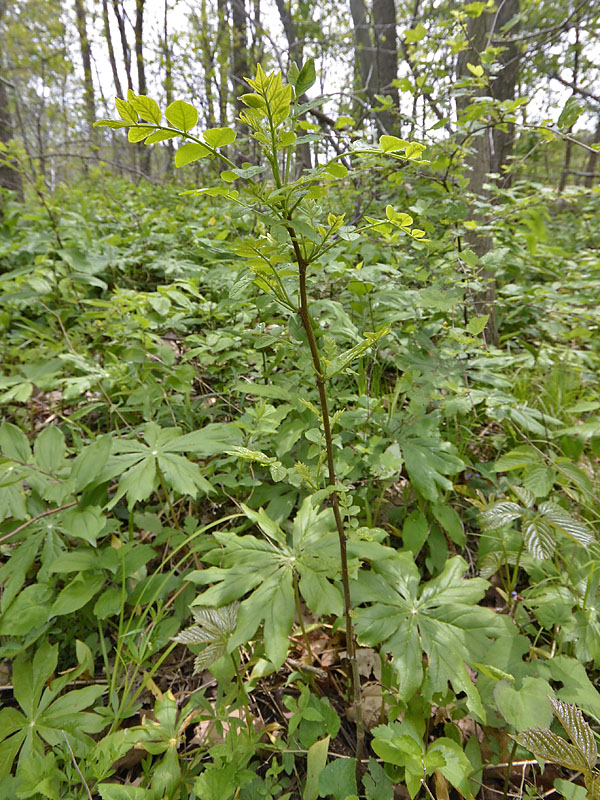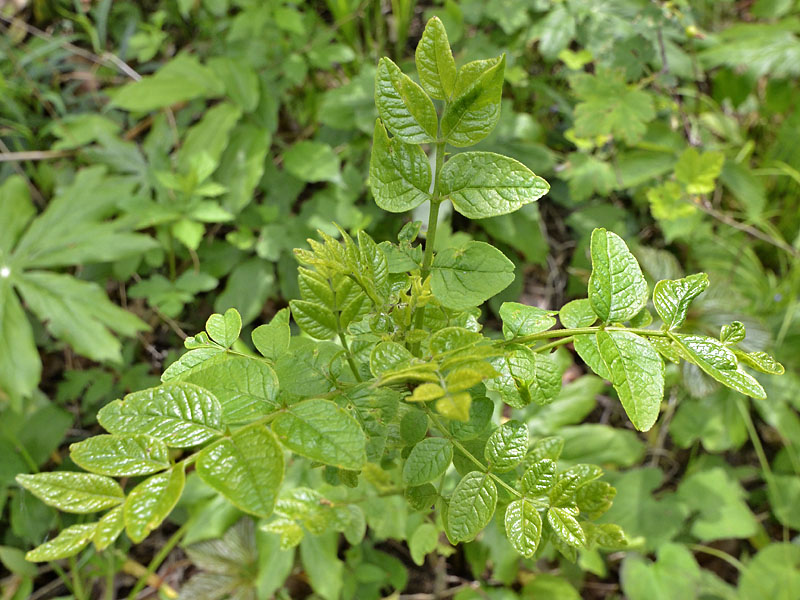
Woody > Zanthoxylum > Zanthoxylum americanum > Zanthoxylum americanum
Zanthoxylum americanum
Northern Prickly-Ash
Origin: Native to Canada and United-States of America.
Mike's
Opinion


"
Zanthoxylum americanum is quite a tall and fast-growing species, reaching heights of up to 10 m. The alternate leaf arrangement is appealing because of the dark green vegetation it provides, and as the flowers bloom the leaves turn a yellowish-green colour. The tree is equipped with 5 -10 mm prickles on the underside of the leaves, hence the name Prickly Ash. Prickly Ash is not prone to disease and may be planted in poor soil areas.
Michael Pascoe, NDP., ODH., CLT., MSc. (Plant Conservation)
"
| Family |
| Rutaceae |
| Genus |
| Zanthoxylum |
| Species |
| americanum |
| Category |
| Woody |
| Type |
| Tree (deciduous), Shrub (deciduous) |
| USDA Hardiness Zone |
| 3 - 7 |
| Canadian Hardiness Zone |
| 4a - 7b |
| RHS Hardiness Zone |
| H7 |
| Temperature (°C) |
| -30- (-15) |
| Temperature (°F) |
| -22 - (5) |
| Height |
| 10 m |
| Spread |
| 3 - 4.6 m |
Photographs
Description and Growing Information
Flowering Period
| General Description |
| It is a moderately tall shrub reaching 10 m, with dark green foliage. It produces prickly thorns on the underside of the leaves and hard fragrant capsules. |
| Landscape |
| The Northern Prickly-Ash is better suited as a barrier plant for landscaping purposes. |
| Cultivation |
| This species prefers a well-drained moisture-ridden soil in part or full shade. Although it can tolerate poor soil conditions and drought if need be. The species grows in clumps that produce dense dark green leaf foliage. The plant is urban-tolerate, and can still thrive in the wild. It will openly migrate by the root suckers to form large and dense foliage. |
| Shape |
| Round and widespread when matured, has a very full look to it. |
| Growth |
| Fast |
| ID Characteristic |
| Long stems that carry up to 13 leaflets in an alternate leaf arrangement, being compound pinnate. Once the leaves have fallen, the thorns are exposed. They produce reddish coloured nuts that have a pleasant smell to them when scratched or crushed. |
| Pests |
| No serious known pests or diseases. |
| Habitat |
| An understory species often growing in climax forests. |
| Bark/Stem Description |
| The bark has a light to dark grey pattern. |
| Flower/Leaf Bud Description |
| The bud of the Prickly Ash is a orange-red colour and is quite small in size. |
| Leaf Description |
| The alternate leaf is compound and green in colour. |
| Flower Description |
| When the flower is in its growth stage, it has multiple stems growing out of it. They have a green and yellow colour that stays that same colour when mature. |
| Fruit Description |
| Reddish nut-like fruits that grows in clumps. When scratched or crushed, they will produce a pleasant smell. |
| Colour Description |
| When it flowers, it will have a dark green colour to it. Throughout the seasons, it will start to turn into more of a yellow-green, eventually losing its leaves and exposing the light grey bark. It also has reddish nuts that form in clumps. |
| Texture Description |
| It is a medium-textured plant. |
| Propagation |
| The seed is best sown when it is ripe in the autumn. If the seeds were stored, they may require 3 months of stratification. Germination should take place in the late spring, even though it could still take up to 12 months. Scarification of the seeds can also help with germination. |
| Ethnobotanical Uses (Disclaimer) |
| This species was used as a medicine for toothaches; the Indians would chew on the fruits or stems of the plant, as it would cause a numbing effect in the mouth. |
References
Dirr, M. (1998). Zanthoxylum. In Manual of woody landscape plants: Their identification, ornamental characteristics, culture, propagation and uses (6th ed., p. 1325). Champaign, Illinois: Stipes Pub.
Schiller, C., & Schiller, D. (2008). The aromatherapy encyclopedia: A concise guide to over 385 plant oils (p. 234). Laguna Beach, California: Basic Health.

